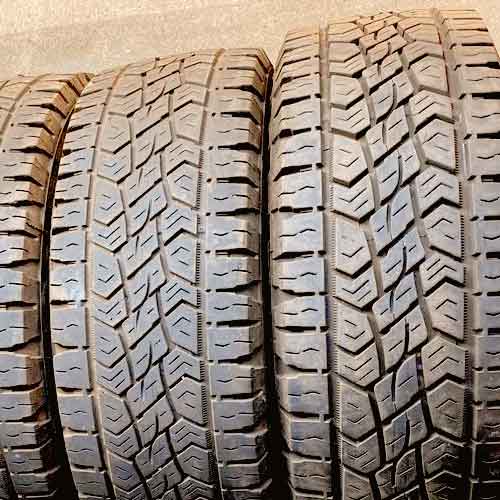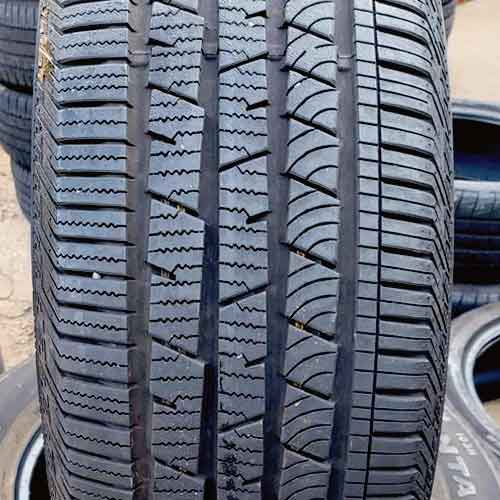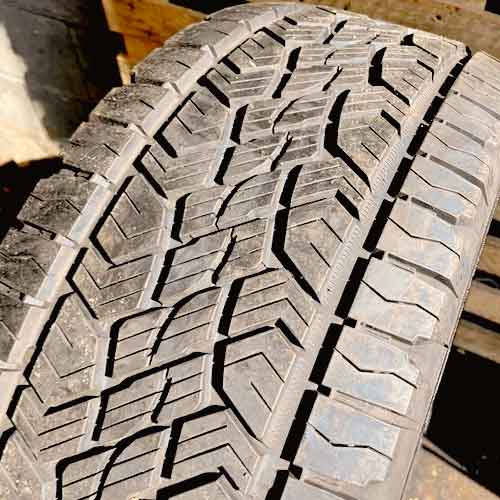We are seeing serious progression in the Light Truck Tire market, and both the Continental TerrainContact AT and the CrossContact are leading the pack, especially when it comes to on-road oriented picks. Both of them offer a great balance of performance and comfort, but which one is the best pick for you? Let’s find out.

As a tire designer and engineer, my experience with these boys tell me that, the Continental TerrainContact AT is up for the win, when it comes to off-road terrains, as the tire features more open tread design and powerful durability. The CrossContact LX on the other side, supplies much better results on pavements, in terms of traction, fuel economy and overall ride comfort. Though its most impressive attribute is it’s winter and wet performance.
Tire Sizes
The Continental TerrainContact AT comes in a total of 38 sizes, with following specs.
- Sizes: 16 to 20 inches wheels.
- Speed rating: S, T, H, and V.
- Load ratings: SL to E.
- Weight range: 28 to 66.5 lbs.
- Tread depth range: LT sizes have 16/32″, and P metric have 12/32″.
- Winter ratings: Not available with 3PMSFR.
- Tread warranty: 60k miles.
Detailed review of this tire: https://tiredriver.com/continental-terraincontact-at-review/
On the other hand, the CrossContact LX comes with following.
- Sizes: 15 to 18 inches rims.
- Speed ratings: S, T, H and V.
- Load ratings: SL and XL (LT sizes not available).
- Weight range: 24 to 37 lbs.
- Tread depth: Either 11/32″ or 12/32″.
- Winter ratings: Only M+S.
- Tread warranty: 65k for S and T (speed rated) sizes, and 50k for H and V rated.
Tread Structure
Continental CrossContact features a very on-road oriented structure.

It’s asymmetric design consists of 3 longitudinal ribs in the middle, forming 4 vertical channels.
The central most rib is made continuous (like the rest), and it features wave-like full depth siping and notches.
The (right-side) surrounding rib, these notches are facing, have smaller lugs with curved siping pattern.
While the one on the left side, has similar structure compared to the middle one, though lugs here are slightly wider.
Shoulder lugs are also different on both sides. They carry rectilinear sipes, on one side, while the other comes with wave-like pattern.
Moving towards the other tire, the Continental TerrainContact A/T features a more aggressive structure. Though it’s still one of the most on-road oriented tire in the all-terrain category.

It’s tread features very blocky shoulder lugs, with connectors in between (the lateral voids), and full depth siping.
They are separated form the middle section with prominent, and wider longitudinal grooves.
In the middle there are 3 ribs, forming 3 more of these circumferential channels.
The lugs on the middle most have super cool curved notches, rectilinear sipes, and foundational supports of secondary rubber layers.
While the surrounding ribs have similar siping patterns and also feature sharp teeth facing the shoulders (called snow vices).
Furthermore, all of these blocks also have secondary rubber layers underneath, for surface stability.
Tread Life
Treadwear on both tires is pretty similar on average, and it makes sense why both of them are rated with similar UTQG ratings of 680 A B.
Though note that with greater speed ratings, the rolling resistance also increases and the tire wears faster. I covered it all here: https://tiredriver.com/speed-rating-on-tires/
That’s why Continental CrossContact LX provides greater, 65k miles treadwear warranty for S and T rated sizes, whereas the H and V rates sizes get 50k.
Longitudinal Grip
The section width and footprint of a tire are the main dimensions that affect grip, and in case of longitudinal or directional grip, central section is taken into consideration, as that areas bears the most weight when a tire moves in a straight line.
That’s why upon testing, the CrossContact LX shows up with shorter stopping distances (upon braking from 50 mph), on average, thanks to it’s dedicated central most circumferential rib.
The TerrainContact A/T on the other side, isn’t able to form as much contact, on road, form it’s rubber, as its central area is more voided and interlocked.
Lateral Grip
Like the directional grip, the lateral traction is also judged by looking at the footprint, though here, shoulders are considered, as they create a larger contact patch with the road.
And here again the Continental CrossContact LX with it’s extremely compacted up blocks, supply better overall handling.
The TerrainContact A/T in comparison, with more spaced up lugs, and heavier weight causes blocks to bend more (during cornering), and this results in relatively limited steering sensitivity, and handling.
Wet Traction
Water is not compressible, so in order for the rubber to grip, it has to be cleared off in time. And that is done by grooves and sipes.
Both tires offer 4 aqua channels, so a bulk of water leaves out form these grooves, though the little left behind is cleared off better on Continental CrossContact, as the tire features a lot more number of sipes along with tread flexibility.
Sipes basically soak up water in their slits, so they have to expand, and with a pliable compound, the CrossContact does a better job at that.
The TerrainContact on the other hand, not only has limited siping, their rectilinear pattern tends to get stiffer (especially during cornering), moreover, the tire’s overall harder tread compound isn’t helping that either.
Off Road Traction
The major difference between both tires is seen on rugged off-road tracks. Both of these tires were tested on following terrains.
On Sand
On sand you need to avoid digging, and although it may make sense to use a lighter tire here, it wouldn’t always offer the expected results.
The Continental CrossContact LX is almost half in weight compared to it’s counterpart, yet its packed up lugs and missing sidewalls, don’t allow for greater traction.
Whereas on TerrainContact A/T the voided shoulder lugs provide paddling, and the sidewall lugs spread out (by lowering the air pressure), and they offer the needed contact patch.
So even with a heavier structure here, the overall grip is superior.
On Mud
Mud is one of the toughest of all, and here tires with bigger tread voids do better with their self cleaning features.
That’s why out of them, we have a clear winner, the TerrainContact A/T. It offer numerous pathways for the thick mud to move out in all angles, with it’s interlocking central blocks.
Moreover, before entering the tread, the mud is also able to break down in to smaller particles with the help of in-groove notches, this accounts for better mud evacuation efficacy.
The CrossContact LX on the other hand, is too crowded with lugs, to be able to handle any kind of muddy tracks, as it would simply get clogged with it quickly.
On Rocks
Rocky terrains are two parts, we have rock climbing rocks at one hand, and traction on gravely and dirt filled roads, on the other.
For climbing, you need very gripping tires (in all directions), as without it, your ride can face overturning (in the worst case scenario).
That’s why out of both tires, you’d be better off with TerrainContact AT, as it delivers better biting abilities at multiple angles.
It’s central interlocked section offer most of the directional traction, whereas it’s shoulders with bigger groove mouth, and attaching sidewall lugs, supply for lateral traction, especially with reduced air pressure.
On gravely roads, the tire features a more durable cut resistant rubber unlike the CrossContact LX, and with a superior self cleaning tread, it doesn’t invite as many “sharp” rock to get stuck in, and cause damage besides compromising on traction.
Fuel Consumption
With a durable inner construction, and a thicker rubber layer on top, the Continental TerrainContact gets to be much heavier in comparison. So it eats up more fuel, rolling it’s greater weight.
The CrossContact LX on the other side, doesn’t offer any LT sizes, and its heaviest weight only goes up to 37 lbs, that’s 30 pounds lighter compared to it’s A/T.
Moreover, with it’s packed up lugs, that weight further gets more evenly distributed, enhancing fuel economy.
Winter Traction
Winter performance is tricky for both tires, though out of them, the CrossContact LX is up for the win.
The tire’s asymmetric tread structure with a mixture of rectilinear and interlocking sipes supply greater biting abilities on all types of surfaces, may it be soft snowy roads or ice.
Whereas the Continental TerrainContact A/T only does better on deeper terrains.
Yet, both tires don’t get to have 3 peak mountain snowflake ratings, as their tread compound is not that thermal adaptive.
Even though they both carry a lot of biting edges, with freezing temperatures, they are not that flexible to grab in to the snow, effectively.
Take Home Points
Comparing both tires reminded me of my post, all-terrain vs all-season tires, as there are very similar results here.
Let’s start with on-road traction. So here, considering overall grip, handling and steering sensitivity of both tires, I can confidently say that you’d find CrossContact LX considerably better out of both tires, in both wet and dry environments.
The tire’s asymmetric design account for superb bite on dry roads, whereas it’s dual siping structure and longitudinal grooves supply wet traction, and resistance to hydroplaning.
These biters are also much more effective when it comes to winter terrains as well, though the tire is not rated with 3PMSF, like its counterpart too, though they both still have M+S.
Moving on to the other tire, the TerrainContact A/T features superior off-roading, as it’s independent central lugs supply for greater self cleaning abilities, and bite on rugged terrains.
Moreover, the tire is also much more durable in comparison.
On-road, although it lacks to its competitor a little, there’s no way, it going to disappointing at all. In fact, it’s the fastest and quietest of all the A/T tires I’ve reviewed here so far. And I think I’ve covered them all. Let me know if you agree.
Awesome work Ozmen.
We dont have the TerrainContact available in Australia, but the Cross/Contact is available and your review is swaying me to get a set. Thanks
Thanks, I am glad that the article helped you a lot.